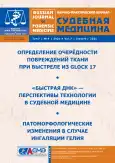Pathomorphological changes due to helium inhalation: an expert case report
- Authors: Aleksandrova L.G.1, Anisimov A.A.1,2
-
Affiliations:
- Kazan State Medical University
- Kazan (Volga Region) Federal University
- Issue: Vol 7, No 4 (2021)
- Pages: 39-44
- Section: Case reports
- URL: https://journals.rcsi.science/2411-8729/article/view/122428
- DOI: https://doi.org/10.17816/fm665
- ID: 122428
Cite item
Full Text
Abstract
BACKGROUND: Helium, being an inert substance, does not have a significant effect on the human body, but sometimes at very high concentrations in the air, it can cause suffocation and a state of oxygen deficiency. Oxygen-helium therapy has proven to be the most effective recovery, rehabilitation, and treatment for all types of lung damage and reduced saturation. It is even included in the recommendations for preventing, diagnosing, and treating COVID-19.
Deaths due to inhalation of inert gases, especially helium, are sporadic in forensic practice. As a rule, the probability of death in such cases is most often associated with man-made accidents or violations of safety regulations when performing technological processes and operations related to the use of gas.
Safety instructions for handling helium warn of possible damage to the mucous membrane of the eyes and frostbite of the skin, as well as mechanical injury when a heavy gas cylinder falls.
CASE PRESENTATION: Inert gases do not interact with other chemicals. However, we encountered a suicide case where an inert gas was chosen as a means. Inhalation of helium caused macro- and micromorphological changes in the human body, which led to a fatal outcome.
The case is illustrated by photographs of microscopic preparations, which demonstrate the absence of specific signs of toxic effects on the organs and tissues of the deceased.
CONCLUSION: Despite the substance’s extreme volatility, the compressed gas’s pressure and low temperature can cause various injuries and even death. The study of general pathomorphology can be helpful in the conduct of a forensic medical examination.
Full Text
##article.viewOnOriginalSite##About the authors
Lilya G. Aleksandrova
Kazan State Medical University
Author for correspondence.
Email: lilya-aleksandrova@yandex.ru
ORCID iD: 0000-0001-6332-8757
SPIN-code: 4392-6853
MD, Cand. Sci. (Med.)
Russian Federation, 49, Butlerov street, Kazan, 420012Andrei A. Anisimov
Kazan State Medical University; Kazan (Volga Region) Federal University
Email: aa_anisimov@bk.ru
ORCID iD: 0000-0002-5323-7226
SPIN-code: 8870-5382
MD
Russian Federation, 49, Butlerov street, Kazan, 420012; KazanReferences
- Whitt A, Garland EL, Howard MO. Helium inhalation in adolescents: characteristics of users and prevalence of use. J Psychoactive Drugs. 2012; 44:365–371. doi: 10.1080/02791072.2012.736803
- Nowak K, Szpot P, Zawadzki M. Suicidal deaths due to helium inhalation. Forensic Toxicol. 2019;37:273–287. doi: 10.1007/s11419-019-00473-2
- Byard RW. Changing trends in suicides using helium or nitrogen – a 15-year study. J Forensic Leg Med. 2018; 58:6–8. doi: 10.1016/j.jflm.2018.04.007
- Chang SS, Cheng Q, Lee ES, Yip PS. Suicide by gassing in Hong Kong 2005–2013: emerging trends and characteristics of suicide by helium inhalation. J Affect Disord. 2016; 192:162–166. doi: 10.1016/j.jad.2015.12.026
- Lyubovitsky AV, Korotun VN, Chemurzieva NV. Changes in glucose content in victims of mechanical asphyxia. In: 3rd All-Russian Congress of Forensic physicians: collection of materials. Part 2. Saratov; 1992. Р. 312–314. (In Russ).
- Alexandrova LG, Nigmatullin NS. Changes in blood glucose concentration as a diagnostic test of lifetime hanging. In: XIV Plenum of the All-Russian Society of Forensic Physicians (June 17–18, 1999): collection of materials. Moscow; 1999. Р. 48–49. (In Russ).
- Prevention, diagnosis and treatment of new coronavirus infection (COVID-19). Temporary methodological recommendations. Version 13 (14.10.2021) (approved by the Ministry of Health of Russia). (In Russ). Available from: https://static-0.minzdrav.gov.ru/system/attachments/attaches/000/058/211/original/BMP-13.pdf. Accessed: 15.11.2021.
- Shogenova LV, Petrikov SS, Zhuravel SV, et al. Thermal helium-oxygen mixture as part of a treatment protocol for patients with COVID-19. Annals of the Russian Academy of Medical Sciences. 2020;75(5S):353–362. (In Russ). doi: 10.15690/vramn1412
- Berganza CJ, Zhang JH. The role of helium gas in medicine. Med Gas Res. 2013; 3:18. doi: 10.1186/2045-9912-3-18
Supplementary files










